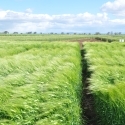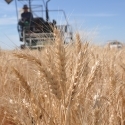Longerenong Canola Challenge Results
 Longerenong general manager John Goldsmith with contestants Anton Mannes (Pacific Seeds), Andrew Stephan (Agritech Rural), Matt Beddison (SMS Rural), Jamie Petrass (Elders) and Steve Fischer (Landmark).
Longerenong general manager John Goldsmith with contestants Anton Mannes (Pacific Seeds), Andrew Stephan (Agritech Rural), Matt Beddison (SMS Rural), Jamie Petrass (Elders) and Steve Fischer (Landmark).
On Tuesday 30th November, the Longerenong Canola Challenge sit e was harvested and the site average yield was an outstanding 3.24 t/ha – which is consistent with the whole paddock which returned the colleges best ever canola crop of 3.2 t/ha over 43 ha.
The teams with the highest yields were SMS Rural (3.63 t/ha), The Longy Students (3.61 t/ha), Green Machine (3.56 t/ha), Team Agritech (3.46 t/ha), the Raging Reds ((3.47 t/ha) and Pac Seeds ((3.44t/ha) – with no significant difference among these six teams.
Congratulations to the Agro Student team from Longerenong College, Bridie Tierney, Ashley Moon, Rob Dye and Tom Brody.; they were up there with the best from all of the commercial teams. Must also congratulate Matt Beddison and Jamie Petrass. Matt from SMS Rural was one of the winning Longy Students in 2009 and has scored again in 2010. Jamie from Elders at Birchip was a Raging Red winner in 2009 and his team got up again.
Crops were sown on April 29 and while most teams used a pre-emergent herbicide (TriflurX), because the site was relatively weed free, none used post emergence herbicides. The trial included 9 canola varieties from a range of herbicide management systems – Roundup Ready, triazine tolerant, Imi-Tolerant (Clearfield) and conventional types. However, each variety was treated with different sowing rates and fertilizers so it is difficult to make conclusions about the genetic ability of each canola variety,
Indeed, if nothing else, this trial shows that the whole package of variety, herbicide group, establishment, weed control and nutrition are important in achieving a good result with canola.
In a year with lots of stored water and in-season rainfall, nutrition was critical to success of the crops. The site had a lot of N at sowing (160 kg/ha top 60 cm) and with a good soil organic C level, it was estimated that another 60 kg N could be mineralised during the season. Groups that elected to have the soil test values for the experiment would have known that this is enough to supply adequate N for a 3 t/ha canola crop. With that information, only modest fertilizer N applications were used, but where yields were below this target, probably due to variety difference, the extra N applied was not likely to have been used. This emphasises the importance of soil testing – in combination with understanding how the season rolls out - to make reasoned fertilized decisions.
Crop annual gross margins were estimated for each team. Teams could forward sell grain at any time during the year, but unlike last year, the highest prices were on offer at harvest rather than earlier. When taking all costs into account, all teams achieved very respectable gross margins of over $1000/ha. The SMS Rural team and the Longerenong Student team both achieved returns over $1500 - which is a fantastic result.
Plans for 2011.
The site has been set up as a long term site, to compare profits from each team over a longer term. Decisions such as applying gypsum and the residual value of 2010 N applications may give benefits to future crops.
In 2011 the trial will be sown to wheat. Each teams crop will go into the same plots as 2010 and once again they will a choice of variety, sowing time, fertiliser, crop protection products and marketing decisions.
Downloads of Results from 2010.
Table 1 - Agronomy Summary - Table 1.pdf
Table 2 - Seed Yield and Oil Contents - Table 2.pdf
Table 3 - Financial Summary - Table 3.pdf
Table 4 - Apparent Nutrient Balances - Table 4.pdf
Table 5 - Soil Test Values and Interpretations - Table 5.pdf




